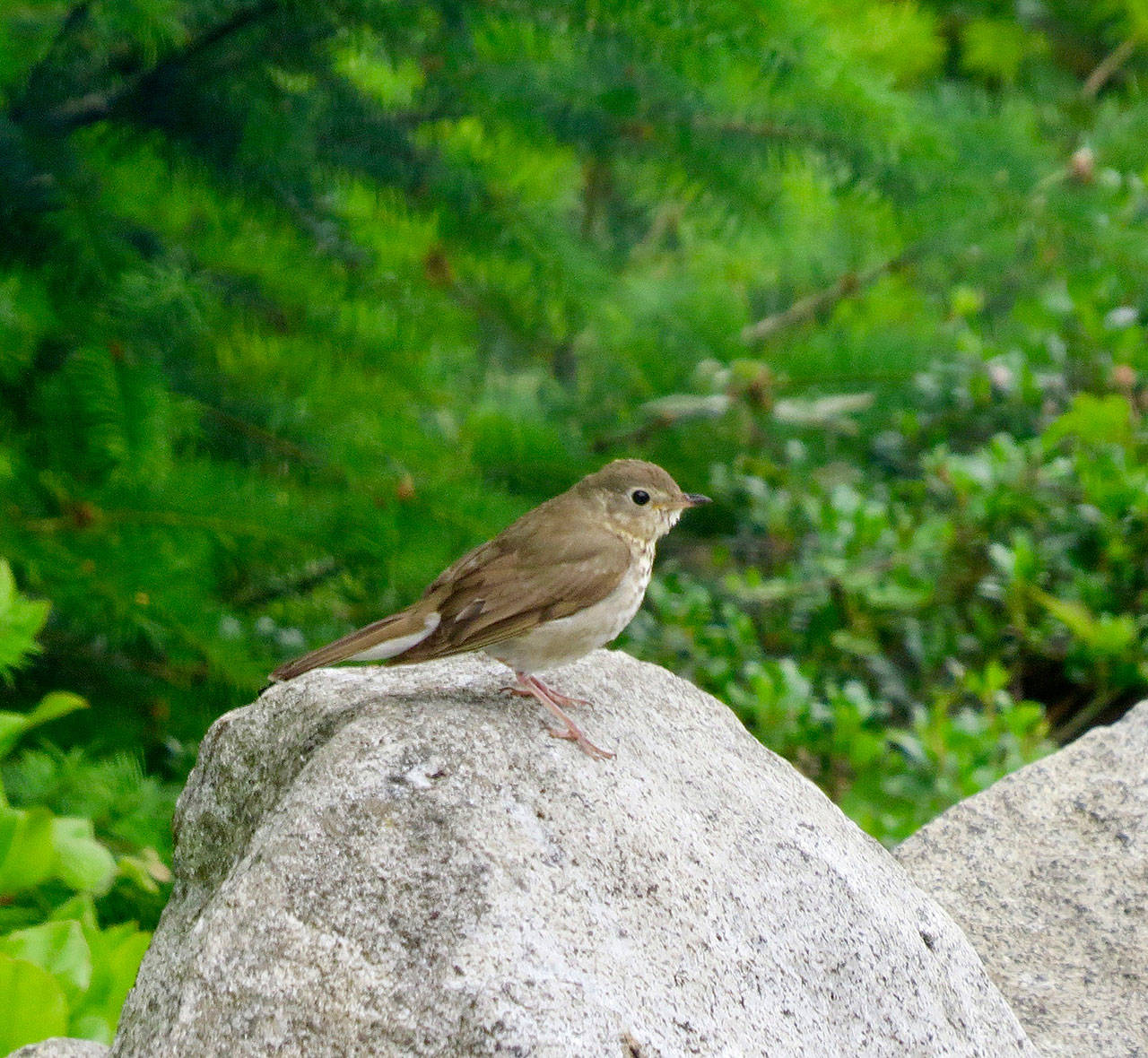Swainson’s Thrush
The quintessential summer soundtrack in Vashon’s forests is the unmistakable swirly whistle of the Swainson’s thrush. According to Ed Swan’s book, “The Birds of Vashon Island,” Swainson’s thrushes return to Vashon at the end of April, raise their young in the summer and leave in September. They spend the winter as far south as northern Argentina.
Thrushes have a double voice box called a syrinx, from the Greek word for panpipes. It allows them to sing two notes simultaneously to create the flute-like harmonies that echo throughout the forest.
Robins are the most familiar and gregarious bird in the thrush family; bluebirds and varied thrushes are the most beautiful, but it’s the shy, inconspicuous thrushes inhabiting the shrubby understory that fill the forest with ethereal music and have inspired poets for centuries. Shakespeare, Thomas Hardy and George Meredith lauded the melodies of thrushes in England and “The wondrous chant of the gray-brown bird,” resonates throughout Walt Whitman’s “When Lilacs Last in the Dooryard Bloom’d.”
Scotch Broom: Sunny appearance belies its diabolical nature
By Chris Woods
This is the first in a series of articles this summer on invasive species. Detailed information on identifying and controlling them is available online at kingcounty.gov/weeds.
Human attempts to label things in nature as good or bad often doesn’t end well. Wetlands were once called swamps, and many of them were filled in or paved over in a misguided attempt to eliminate the perceived evils lurking there. Scientists in the 1970s condemned rare native madrone trees for infesting productive timber acreage and recommended girdling and poisoning them. There’s clearly a danger in viewing species and ecosystems through cultural or cultivation prejudices.
The term “invasive species” has the potential to be one of those tricky labels when it’s applied to creatures and plants. Generally, invasive plant species are non-natives that have an adverse affect on habitats. King County lists more than 100 invasive plants as “noxious weeds,” and the scientific research behind their condemnation is sound.
We have a lot of these weeds on Vashon because we live on disturbed land relentlessly attempting to revert to forest. This opens a window for opportunistic plants able to thrive in diverse environments and grow faster than the natives they replace.
Three of the most obvious Vashon invasives are Scotch broom, English ivy and Himalayan blackberry. You can tell from their names they’re not from around here. They were imported by people who were seduced by their attributes and ignorant of their darker nature.
Scotch broom lights up untended fields in late spring with banana-yellow blooms and especially thrives on the sunny, sandy bluffs of Maury. It’s a European native planted here as an ornamental and for erosion control. You can kind of understand why people thought this plant was a good idea at the time.
But like many invasive species, it’s sunny appearance belies behavior that seems intentionally diabolical. Scotch broom creates wastelands. It displaces natives such as salal, ocean spray and Nootka rose, which are important for pollinators and birds. It crowds out seedlings of native trees, and its highly-flammable nature raises the risk of intense fires. In a sinister twist — fire increases its seed germination.
As a member of the legume family, it fixes nitrogen in the soil. Higher nitrogen levels cause other weeds to grow faster at the expense of natives. Seeds and other plant parts are toxic to humans and animals, so fields containing Scotch broom become worthless as pasture, park or forest.
It’s not that hard to kill Scotch broom. Smaller plants can be plucked by hand, especially when the soil’s damp. Larger plants can be removed using a weed wrench to uproot them. The Vashon Land Trust and Tool Library lend these out.
Total eradication of Scotch broom is tough. A single Scotch broom plant can produce tens of thousands of seeds a year. Each pod cracks open to propel seeds up to 10 feet away, and each of those seeds can remain viable up to 60 years. It’s critical to remove plants before seedpods form in order to make any headway towards eradication.
King County acknowledges Scotch broom is so widespread that control is not feasible and doesn’t require property owners to take any action. But that doesn’t mean we shouldn’t try to keep it from getting worse on Vashon. Removal projects are underway on some public lands, and each of us can help by going out now when they’re easy to spot and removing as many as possible before the next generation of seeds is dispersed.


